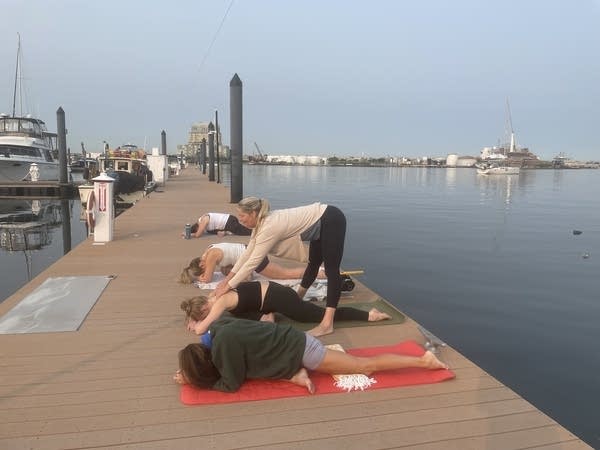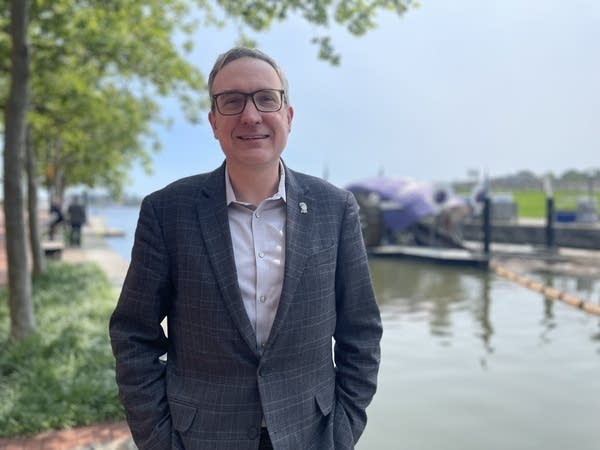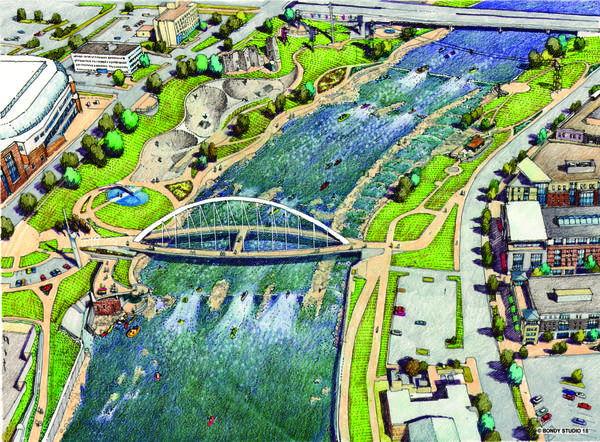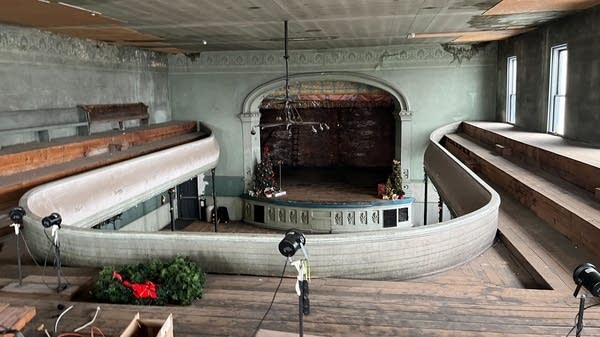“There's still that perception of ‘Ew, I don't want to fall in the harbor,’” as cities push for water recreation
There’s an emerging trend among cities to treat their rivers as recreational assets. But for those with histories of pollution, it requires some convincing.

It’s a little before 6 a.m. at the Baltimore water front, and Jessie Benson, owner of B’More SUP, is about to lead a group of half a dozen people on a paddle around the harbor.
“Sorry, watch the goose poop,” warned Benson, as people move from the dock onto their boards.
It feels like nature is meeting business here. Along with goose poop and bird chirps, there are train whistles and cargo ships. Benson opened this paddle boarding location on the harbor just last summer. The business overall is more than a decade old.
“We’ll just paddle that way, toward the sunrise,” Benson told the paddle boarders. “And then we’ll do yoga right in this area.”
It may seem a little unusual to paddle for fun in Baltimore’s harbor, which is known more for shipping and manufacturing than water sports. But Cortney Marshall, who’s training to be an instructor at B’More SUP, wasn’t fazed.
“I feel like I'm not going to fall in, so I'm a little bit less worried,” said Marshall.
The class costs $40, and there are only a handful of people signed up today. Benson said it’s been slow going at these harbor locations, partly because people are worried about getting wet.
“They're nervous to try paddle boarding on the Inner Harbor,” said Benson. “There's still that perception of ‘Ew, I don't want to fall in the harbor.’”

There’s an emerging trend among cities built on rivers to treat their waterways as economic assets for recreation, making them places where people are willing to spend money as they kayak, paddleboard, swim — in some places, even surf. This is an effort to both attract and keep residents and to bring in tourism dollars. But for cities with histories of polluted waterways— that is to say, a lot of them — it can require some convincing to make people jump in.
At Baltimore’s harbor, it’s still relatively early days for the water sports scene, according to Adam Lindquist, vice president of the Waterfront Partnership. It’s one of the groups behind an initiative that started 15 years ago to clean up the harbor. There has been a marked improvement in Baltimore’s water quality since then.
“We say the harbor is conditionally swimmable,” said Lindquist.
Last year, Baltimore held its first organized public swim in the harbor in over 40 years. Tickets are sold out for another one being held later this summer.
“The end game is that we want a public swimming spot in the Baltimore Harbor, so that people can come down and swim on their own whenever they feel like it,” said Lindquist.
For the time being, Lindquist said to avoid swimming in the harbor outside of organized events. There’s still lots of commercial shipping here, and there are also some conditions that make a dunk unsafe. For example, when it rains, that can cause the city’s sewer system to overflow.

“That carries bacteria into the harbor that can make people sick,” said Lindquist.
It takes about two days for that bacteria to die off. And when you do jump in, you probably shouldn’t touch the bottom.
“We have a very industrial past in Baltimore City, like many cities, and basically, you don't want to stir up the sediment at the bottom of the harbor,” said Lindquist.
There are still challenges with pollution, including a recent diesel spill in the harbor. It was in a contained area, and Lindquist says it won’t affect the upcoming harbor swim. But it doesn’t help build the image of Baltimore as a swimming mecca.
“Overcoming the stigma is just as hard as overcoming the pollution,” said Lindquist.
This move to treating urban rivers as recreation destinations is a shift. For decades, cities were more interested in protecting themselves from water as opposed to jumping in it.
“We walled ourselves off from rivers and waterfronts out of fear,” said Brian Trusty with PROS Consulting. His firm advises places, including Baltimore, on parks and recreation systems. He said over the last 20 years, that attitude has changed. Now, he’s getting calls from places around the country that want to turn their waterways into economic engines.
“Communities are seeing each other. They’re seeing examples. They're like, ‘Oh, I want that,’” said Trusty.
One place Trusty’s worked with on this is Des Moines, Iowa, where Stephanie Oppel leads the nonprofit Iowa Confluence Water Trails, or ICON Water Trails.
“Iowa does not have the ocean. We do not have mountains. But we do have rivers,” said Oppel.
In 2022, it found that recreation on the water in Des Moines and the surrounding areas brought in more than $11 million in consumer spending. Over half of that was from tourists. It’s expecting to about double that yearly spending by making some of its waterways not just boatable — but also surfable.
“We are putting in what's called a wave shaper. It is this big mechanical flipper that can create a surf wave,” said Oppel. “So, late next summer, people will be surfing on the Des Moines River.”

This is not cheap: Oppel said the wave shaper cost a million dollars. These kinds of projects also take a lot of time, and one challenge is keeping the momentum going.
“Making sure that people understand that this isn't going to be built tomorrow,” said Oppel. “But it will be built in a couple of tomorrows.”







!["I think [AI] is really cool. There is stuff out there that is fun to watch," said Bella Falco of Denver, Colorado. "There are also things that starting to really scare me, like fake creators."](https://img.apmcdn.org/cb0a9a7e54db934026285b941f4b74ded3dab5ea/widescreen/53f6b2-20251113-bella-falco-sitting-on-a-striped-couch-with-a-mug-600.jpg)





